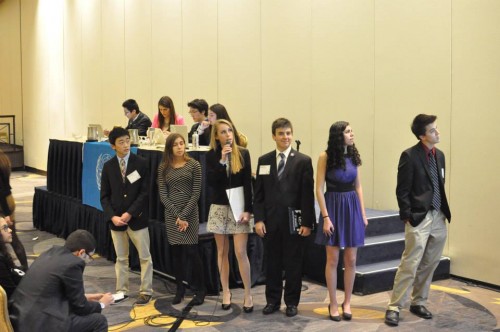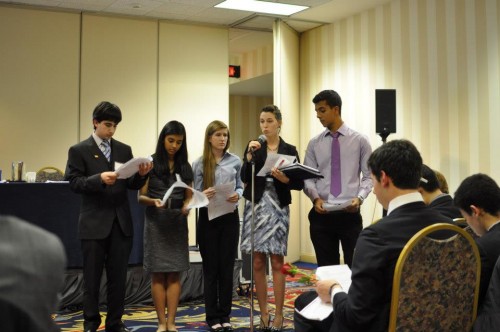
Delegates present their draft resolution in the World Health Organization
Do be the first to introduce the draft resolution and answer the first question. When you start off speaking during both the introduction and the Q and A portion of the presentation, it leaves a strong first impression on the delegates and the dais and makes you look like a confident leader. In addition, it puts you in the position to set the tone for your draft resolution.
Do Not be rude. Many delegates will go into presentation period and act very aggressive, cutting each other off and trying to answer all the questions. This comes off as undiplomatic to other delegates and the dais. Other delegates will not be inclined to join your bloc if it doesn’t look cooperative and the dais will not appreciate the blatant disregard for professionalism and will take it into consideration when for awards. If there is a member of your bloc who is being rude during the presentation period, call them out on it by requesting the speaker to let other delegates answer the rest of the questions.
Do divvy up questions. If who answers which question is not decided beforehand, the presentation period can quickly dissolve into chaos, with delegates fighting to answer a question. The best way to go about q and a is by instituting the rule “if the question is about your clause, you answer it.” This simple rule ensures that there will be no drama during Q and A. It also ensures that the delegate who knows the most about the specific topic referenced in a question as it pertains to the draft resolution, answers it. Furthermore, if you have written the majority of the draft resolution, the rule puts you in a position to answer a majority of questions without having to fend off other delegates in your bloc.

Delegates presenting their draft resolution
Do Not merge with delegates who will try to overpower you in the presentation period. After mergers, Q and A is where the leaders of the merged blocs come into light. If you set yourself up for an aggressive Q and A, you are setting yourself up for failure. When merging look for delegates who will compromise and collaborate with your bloc. In addition, look for draft resolutions that are less comprehensive than your draft resolution in both scope, length, and quality. This ensures that your merged working paper will include more of your clauses and thus you will be in a position to answer more of the questions during the Q and A if you implement the aforementioned rule.
Do call on delegates in your bloc to ask questions during Q and A. For the delegates in your bloc who did not come up for Q and A, the best way to keep them involved is by working with them to prepare questions beforehand. These questions should give you the opportunity to highlight the key elements of your draft resolution.
The presentation and Q and A portion of a conference is where many gavels are earned. Take the time beforehand to set yourself up well by contributing substantive ideas to your paper and following the above rules. Respect and professionalism will be reciprocated, and success at this time will be rewarded at closing ceremonies.


